


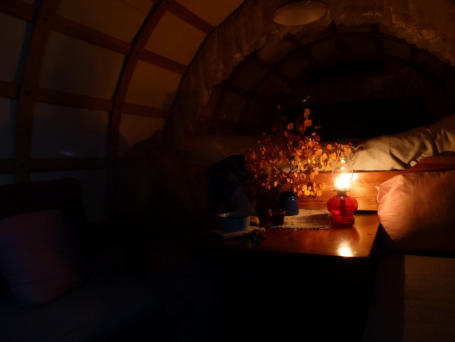


© 2014-2021 Copyright by P. K. H. Groth, Denver, Colorado, USA All rights reserved - See contact page for for permission to republish article
excerpts.
Sheep Herder Wagon Camp for Rent
This is a replica sheep herder wagon built on original 1880’s running gear. This is
available to select people when we are not using it, and when we can place it at an
appropriate Denver area location, or where else we may be using the camp at the time.
It is too heavy to allow others to safely transport it. The rental price depends on the
location and days used and how far we have to deliver it; approximately $ 700 - 200 per
day plus damage deposit.
Non smokers only - the canvas, interior furnishings and feather bedding are costly or
impossible to clean of smoke. No pets, because we can not then rent it to people who
have pet fur alergies.
Consider renting the sheep camp for
a wedding honeymoon present,
anniversary surprise “mystery get-a-
way”, a party theme centerpiece, etc.
Inquire for description and
particulars at
geochemistry4u@centurylink.net
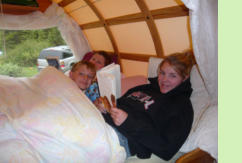
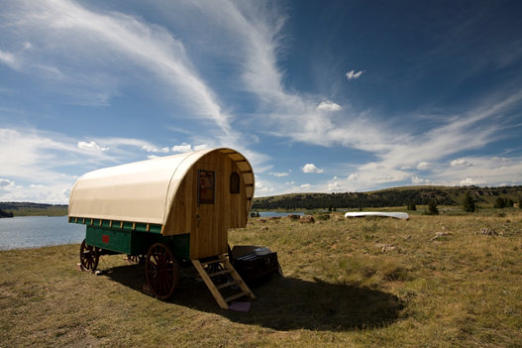
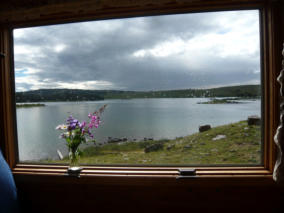
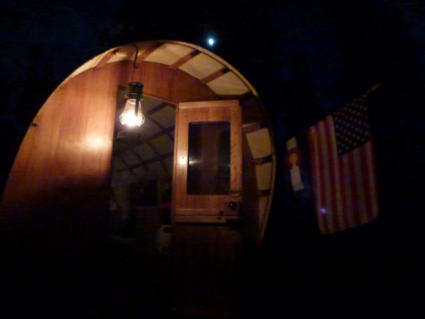
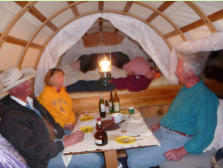
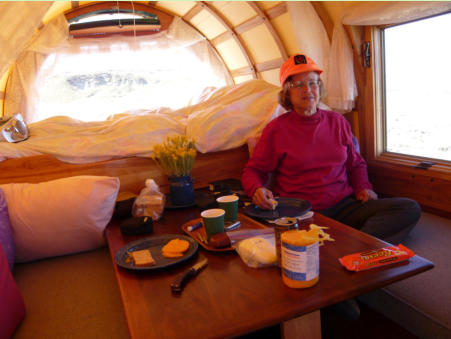
Kolb-Groth Sheep Camp
Origins of Western US Sheep Wagons
There were vague predecessors to what eventually became sheep camps. European wanderers often lived in self
contained homes called gypsy wagons. They were usually quite ornately decorated, since the entire family lived in
them. The wives wanted some "class", so the woodwork was ornate, the small windows had curtains, and the
interior and exterior were often gaudy with joyful colors. The gypsy wagons in their day were symbolic of ownership
pride, much like the colorful decorated buses and taxis of today's India and Africa.
English sheep owners usually brought their sheep to a common, secure area at night. Yet, they wanted to give their
herdsmen some daytime protection from the nasty rains and dampness. They devised what is best described as an
outhouse perched on a cart. The herder could observe the sheep though small windows.
Sheep herders in the western United States moved great herds over large areas, ever shifting the flocks to new
forage areas as the sheep ate existing grass. This required herders to be highly mobile. Shelter was typically a small,
pyramid shaped tent under which the herder huddled in his bedroll. A fire ring, small spirit stove, kerosene lantern
and simple food provisions could be carried on a packsaddle, or a pack horse for longer excursions.
Early western herders were from many foreign countries. However, eventually the Basque herders proved to be the
best employees for large sheep enterprises. They could handle the idiosyncrasies of sheep, the unfettered
responsibility of tending flocks day and night, and the eternal loneliness. From May to October, herders wandered
the countryside. Sheep owners would intermittently ferry food and supplies to the several herders of a ranch.
In the l870s and 1880s the western US sheep business burgeoned. More herders were needed, and many
prospective hires loathed the life of long hours, hard work, loneliness and miserable living conditions. Something
had to be done, and only the last item could be improved - living conditions. Several sheep ranchers attempted to
use wagons to allow more provisions and better tents to be carried. However, Rawlings Wyoming blacksmith and
wagon maker James Chandlish, working with sheep rancher George Ferris, is credited with converting a four
wheeled wagon into the first integrated mobile living quarter. Almost instantaneously, this sheep camp design
would become the template used by many other blacksmith-wagon makers.
By 1886 the Douglas Wyoming Budget newspaper article disclosed the quickly evolved sheep camp being sold by
the Florence Hardware Store. The sheep camps were probably made by blacksmith George Douglas, who was born
in Wisconsin in 1856 and trained there as a wagon maker.
The "standard" sheep camp had a transverse bed over drawer and bin storage areas. A canvas partition rolled down
in front of the bed to conserve heat for the sleeper. (Canvas inner-ceiling liners were also often used in cold
weather.) Benches ran on both sides of the rear half of the generally twelve foot long box. A table slid out from
beneath the bed. On one outside was a board or simple storage box in which outside equipment and odorous fuels
were kept. On the opposite side a food storage bin was accessible by lifting up the bench. A small bench top
cupboard-pantry held basic utensils, pots and dishes. A small sheet metal or cast iron wood stove provided heat
and cooking; the stove pipe went through the wagon end wall, or through the roof. The roof was bows bolted to
longitudinal slats, over which a canvas was stretched. Hickory was the favorite wood for the roof because of its
strength and resistance to warping The rear wagon face had a small window above the bed to allow observing
sheep.
Originally, the front end of the camp was a roll up strap-tied canvas door. Around 1900 Marshal Buxton refined
camps he made for Schulte Hardware Company in Casper, Wyoming. He integrated solid wagon ends. The front
door was a Dutch door that allowed the lower half of the door to be closed to prevent dogs and rodents from
entering, and to permit the top to be open for ventilation and watching sheep. A moveable end window was added,
and a cast iron stove (Ferris stove - naturally) was standard. The herdsman would stand in this half closed door
when driving the horse team to new pastures. The wagon tongue was the "step" up into the wagon. Lastly, a
trademark of a sheep camp is the porcelain pan attached to the inside of the lower door. When the pan was placed
on a box outside the wagon, the herder could wash up before entering his "home on the range". Interestingly, many
a sheep herder slipped on the tongue, for obvious good reason. At that time there was a superstition that lightening
would strike a sheep camp on the flat prairie unless the wagon tongue was covered with old bacon grease. Usually a
kerosene lantern was hung from the end of the wagon. This allowed the circuit supply man to find the camp; it also
was a safety beacon for a herder who had to relocate his wagon home on a dark and miserable night.
An auxiliary two wheeled "Coster Wagon" might be towed behind the sheep camp. It would carry herding supplies,
animal mineral salts and replacement equipment. It is interesting to see the supplies list of sheep camp. And the
regulations. Even if a piece of equipment, strap of leather, or food was no good, it had to be returned to the sheep
rancher at the end of the season to prevent wage garnishment!
Sheep camps have modern counterparts. Because they are so space efficient, orderly, and simple to live in they
provided the template for the Airstream aluminum camper trailer, later the pickup truck camper, and finally
contemporary motorhomes.
Kolb Running Gear
The heavy Kolb farm wagon is in excellent condition. The red paint typical of the time is the original, first coat. The
axles, wheel spokes and hubs and the single-tree are hand pinstriped in black paint. The wheel spokes, felloes and
hubs are in remarkably good condition. There is no major damage indicating heavy or even regular usage. The
bolsters lack rub marks, suggesting the vehicle never had a wagon box. The wagon might have been used only
seasonally, perhaps to harvest logs. It is obvious that the wagon was revered with pride, since its condition indicates
it was always stored inside a barn - a luxury for a space-starved farmer.
On the back of the rear axle is painted "W. E. Kolb Mkr Newton WI". The inscription is in the same black paint, of the
same brush, and apparently by the same hand that decorated the running gear axles, wheel spokes and single-tree.
The painting is neat, well executed and graceful, but it is not perfect as one might expect of a professional detailer
working at a large commercial wagon factory. This was made by someone who was adept at many trades -
suspiciously someone local. Of note is the original base red paint; it does not lap over onto the ironwork. This
suggests a proud maker built the wagon, disassembled it, painted the wood, and then reassembled it. Perfection
seems to have been wanted, perhaps since the wagon was to be a show piece to entice future buyers.
There were two W. E. Kolb blacksmiths - William E. the elder and his son Walter E. (1893-1941). Which of the two
built the wagon, and how old is the running gear? A brief telephone inquiry to Charles F. Kolb of Newton, Wisconsin
did not initially disclose who made the wagon running gear. Ione Kolb, daughter of Walter E. Kolb remembers her
father being only a blacksmith, not a wagon maker. However, he did service some wagon hardware. At that time,
Ione Kolb would have been very young and maybe unaware of all her father’s business. Mr. Charles Kolb consulted
local historian Vernon Wernickie, but he did not recall any wagon making in the area. However, a local history of
nearby Northeim describes the prized "candle-straight white pines" being taken down to the Centerville Piers to be
tied into rafts on Lake Michigan for transport to Milwaukee sawmills. Wagons must have been in demand during
these early (1868) days.
We suggest the elder William Kolb must have made the wagon sometime before 1900, perhaps in the period 1870 -
1890. Walter would have been too young to build a wagon before the end of the nineteenth century when mass
wagon makers took over the market. It is reasonable to assume Walter Kolb must have been at least seventeen
years old to attempt making a complex vehicle like a heavy farm wagon. But that would be in 1910, well beyond the
period of local wagon making. By that time there was probably no demand from local farmers who already had
wagons and were converting to steel frame equipment. So why would he learn a dying trade of wagon making from
his father
William E. Kolb (perhaps originally Kolbe?) is most likely the wagon maker. He would have learned the trade from his
old world apprenticeship before emigrating to this country. At this time we do not know his birth-death dates, nor
anything else about him. The lack of a Wisconsin parish death document suggests he may have left Newton (and
Wisconsin?) before dying.
With the present lack of historical details, speculative deductions seem justified. William must have learned
blacksmithing-wagon making in Europe. The apprenticeship would have been lengthy. A fair assumption would be
that William was twenty five years (or more) old when he emigrated to the United States. Then he married and had
a son in 1893. That would guesstimate William's birth date as approximately 1868. It was probably during the 1890
to 1900 period that William made the wagon running gear. Ultra speculation might be the scenario that William
could not sell the wagon as cheap as the mass produced factory wagons, so he kept as a delivery wagon as a sense
of artesian pride. We will approach the descendents for more details of the two blacksmiths.
A note of the wagon’s provenance. My mother, Karin Williams Helenius lived on Carstens Lake Road. She bought
the wagon running gear about 1965 from an auctioneer when no one bid on the obsolete wagon. It remained
disassembled in Karin’s barn in a protected area where it was undisturbed. Her son Peter retrieved the wagon in
2007.
Groth Sheep Camp
Linda and Peter Groth are outdoors people who love history. They resurrected an early 1900’s settler’s cabin in
Wyoming and filled it with garage sale antiques. The cabin is on a large cattle ranch, which formerly had been used
for sheep herding. A fellow geologist friend and the rancher beautifully rebuilt a historic sheep wagon. So building a
replica sheep camp on antique running gear seemed a proper thing to do so that we could savior life of a bygone
day. We use it for camping in the Rockies, hunting antelope in Wyoming, and visiting historic sites in the West.
Redwood, sixteen feet long 2X6 planks reclaimed from a neighbor’s discarded deck were used. They proved to be
ideal, because they had cured while clamped in place for fifteen years and were therefore straight, and had shrunk
as much as possible in the dry Denver climate. The lumber was reverse grain matched, fitted, edge-drilled every
eighteen inches, and glued together with embedded threaded steel rods. The large sections were sanded flat with a
floor sander. The sections were bolted to a welded steel wagon frame.
The bent ribs and lath are made of eastern hickory, and oil finished. The canvas covering is dust tight, a wonderful
modern convenience on the dusty, windy prairie. The canvas is actually a heavy rayon used in boat covers. It shrinks
in the cool night air and minimizes flapping in the wind. Interior cupboard, wainscoting and trim are cherry. The bed
is birch and the slide out table is black walnut.
The door end of the wagon is made of well-aged Wisconsin hard, wavy birch boards laminated in to one “plank”.
There is the characteristic double Dutch door, and a small stove vent door. The bed end of the wagon is laminated
birch and plywood, into which a large Plexiglass picture window was embedded. The “Queen” likes to sleep at the
window and watch the animals at dawn. A high index (no-see-em) glass side window is another site to sit and watch
animals go by, usually unaware of our presence.
The length of the wagon is exceptional long at 16 feet, so it is called a “Honeymoon Sheep Camp”. This size wagon
would have been used by a ranch owner and his wife, who would also come to sheep roundups and shearing.
Sheep camps for single herders were generally twelve feet long. Lighting is by Coleman lantern. The bed is full sized
with a memory foam mattress which dulls vibrations when the wind blows and rocks the wagon. There is a small
wood/coal stove to provide heat and cooking, although usually we prefer to speed cooking and keep the wagon
cooler by using a Coleman Stove. There is interior access to two large coolers and a pantry under one bench. The
opposite side has exterior storage of fuel, wooden buckets, barrels, etc. A large storage area is under the bed
center, and there are two large drawers on the side benches.
We transport the two ton (loaded with provisions) wagon on a dual axle trailer. We offload the wagon at a camp site,
and then hide the ugly trailer down the road. An electric winch hauls the wagon up ramps onto the trailer.
The sheep camp is used for camping in the Rockies and on the plains, hunting and fishing, hiking and general
loafing. Evenings are complimented with a smoky camp fire (wind permitting), reading and listening to old music,
western stories and mystery detective tapes. Entertaining guests or newly met friends is also a delight.




- Hunter welfare
- Hunter poster child
- Altitude sickness
- Hunter heart attacks
- Hunter heart stress
- Altitude sleep problems
- Hunter spine/bone damage
- Back country hazards
- Man made hazards
- Hunter bear attacks
- Bear problems
- Mtn lion Awareness
- Insect problems and diseases
- Hunt camp rodent problems
- Game meat dangers
- Elk meat diseases





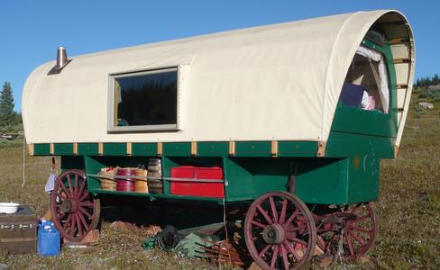
Sheep Herder Wagon
Camp for Rent
This is a replica sheep herder wagon built on
original 1880’s running gear. This is available to
select people when we are not using it, and when
we can place it at an appropriate Denver area
location, or where else we may be using the
camp at the time. It is too heavy to allow others
to safely transport it. The rental price depends
on the location and days used and how far we
have to deliver it; approximately $ 700 - 200 per
day plus damage deposit.
Non smokers only - the canvas, interior
furnishings and feather bedding are costly or
impossible to clean of smoke. No pets, because
we can not then rent it to people who have pet
fur alergies.
Consider renting the sheep camp for a wedding
honeymoon present, anniversary surprise
“mystery get-a-way”, a party theme centerpiece,
etc. Inquire for description and particulars at
geochemistry4u@centurylink.net




Kolb-Groth Sheep Camp
Origins of Western US Sheep Wagons
There were vague predecessors to what eventually
became sheep camps. European wanderers often lived in
self contained homes called gypsy wagons. They were
usually quite ornately decorated, since the entire family
lived in them. The wives wanted some "class", so the
woodwork was ornate, the small windows had curtains,
and the interior and exterior were often gaudy with joyful
colors. The gypsy wagons in their day were symbolic of
ownership pride, much like the colorful decorated buses
and taxis of today's India and Africa.
English sheep owners usually brought their sheep to a
common, secure area at night. Yet, they wanted to give
their herdsmen some daytime protection from the nasty
rains and dampness. They devised what is best described
as an outhouse perched on a cart. The herder could
observe the sheep though small windows.
Sheep herders in the western United States moved great
herds over large areas, ever shifting the flocks to new
forage areas as the sheep ate existing grass. This required
herders to be highly mobile. Shelter was typically a small,
pyramid shaped tent under which the herder huddled in
his bedroll. A fire ring, small spirit stove, kerosene lantern
and simple food provisions could be carried on a
packsaddle, or a pack horse for longer excursions.
Early western herders were from many foreign countries.
However, eventually the Basque herders proved to be the
best employees for large sheep enterprises. They could
handle the idiosyncrasies of sheep, the unfettered
responsibility of tending flocks day and night, and the
eternal loneliness. From May to October, herders
wandered the countryside. Sheep owners would
intermittently ferry food and supplies to the several
herders of a ranch.
In the l870s and 1880s the western US sheep business
burgeoned. More herders were needed, and many
prospective hires loathed the life of long hours, hard
work, loneliness and miserable living conditions.
Something had to be done, and only the last item could
be improved - living conditions. Several sheep ranchers
attempted to use wagons to allow more provisions and
better tents to be carried. However, Rawlings Wyoming
blacksmith and wagon maker James Chandlish, working
with sheep rancher George Ferris, is credited with
converting a four wheeled wagon into the first integrated
mobile living quarter. Almost instantaneously, this sheep
camp design would become the template used by many
other blacksmith-wagon makers.
By 1886 the Douglas Wyoming Budget newspaper article
disclosed the quickly evolved sheep camp being sold by
the Florence Hardware Store. The sheep camps were
probably made by blacksmith George Douglas, who was
born in Wisconsin in 1856 and trained there as a wagon
maker.
The "standard" sheep camp had a transverse bed over
drawer and bin storage areas. A canvas partition rolled
down in front of the bed to conserve heat for the sleeper.
(Canvas inner-ceiling liners were also often used in cold
weather.) Benches ran on both sides of the rear half of
the generally twelve foot long box. A table slid out from
beneath the bed. On one outside was a board or simple
storage box in which outside equipment and odorous
fuels were kept. On the opposite side a food storage bin
was accessible by lifting up the bench. A small bench top
cupboard-pantry held basic utensils, pots and dishes. A
small sheet metal or cast iron wood stove provided heat
and cooking; the stove pipe went through the wagon end
wall, or through the roof. The roof was bows bolted to
longitudinal slats, over which a canvas was stretched.
Hickory was the favorite wood for the roof because of its
strength and resistance to warping The rear wagon face
had a small window above the bed to allow observing
sheep.
Originally, the front end of the camp was a roll up strap-
tied canvas door. Around 1900 Marshal Buxton refined
camps he made for Schulte Hardware Company in
Casper, Wyoming. He integrated solid wagon ends. The
front door was a Dutch door that allowed the lower half of
the door to be closed to prevent dogs and rodents from
entering, and to permit the top to be open for ventilation
and watching sheep. A moveable end window was added,
and a cast iron stove (Ferris stove - naturally) was
standard. The herdsman would stand in this half closed
door when driving the horse team to new pastures. The
wagon tongue was the "step" up into the wagon. Lastly, a
trademark of a sheep camp is the porcelain pan attached
to the inside of the lower door. When the pan was placed
on a box outside the wagon, the herder could wash up
before entering his "home on the range". Interestingly,
many a sheep herder slipped on the tongue, for obvious
good reason. At that time there was a superstition that
lightening would strike a sheep camp on the flat prairie
unless the wagon tongue was covered with old bacon
grease. Usually a kerosene lantern was hung from the end
of the wagon. This allowed the circuit supply man to find
the camp; it also was a safety beacon for a herder who
had to relocate his wagon home on a dark and miserable
night.
An auxiliary two wheeled "Coster Wagon" might be towed
behind the sheep camp. It would carry herding supplies,
animal mineral salts and replacement equipment. It is
interesting to see the supplies list of sheep camp. And the
regulations. Even if a piece of equipment, strap of leather,
or food was no good, it had to be returned to the sheep
rancher at the end of the season to prevent wage
garnishment!
Sheep camps have modern counterparts. Because they
are so space efficient, orderly, and simple to live in they
provided the template for the Airstream aluminum
camper trailer, later the pickup truck camper, and finally
contemporary motorhomes.
Kolb Running Gear
The heavy Kolb farm wagon is in excellent condition. The
red paint typical of the time is the original, first coat. The
axles, wheel spokes and hubs and the single-tree are
hand pinstriped in black paint. The wheel spokes, felloes
and hubs are in remarkably good condition. There is no
major damage indicating heavy or even regular usage.
The bolsters lack rub marks, suggesting the vehicle never
had a wagon box. The wagon might have been used only
seasonally, perhaps to harvest logs. It is obvious that the
wagon was revered with pride, since its condition
indicates it was always stored inside a barn - a luxury for a
space-starved farmer.
On the back of the rear axle is painted "W. E. Kolb Mkr
Newton WI". The inscription is in the same black paint, of
the same brush, and apparently by the same hand that
decorated the running gear axles, wheel spokes and
single-tree. The painting is neat, well executed and
graceful, but it is not perfect as one might expect of a
professional detailer working at a large commercial
wagon factory. This was made by someone who was
adept at many trades - suspiciously someone local. Of
note is the original base red paint; it does not lap over
onto the ironwork. This suggests a proud maker built the
wagon, disassembled it, painted the wood, and then
reassembled it. Perfection seems to have been wanted,
perhaps since the wagon was to be a show piece to entice
future buyers.
There were two W. E. Kolb blacksmiths - William E. the
elder and his son Walter E. (1893-1941). Which of the two
built the wagon, and how old is the running gear? A brief
telephone inquiry to Charles F. Kolb of Newton, Wisconsin
did not initially disclose who made the wagon running
gear. Ione Kolb, daughter of Walter E. Kolb remembers
her father being only a blacksmith, not a wagon maker.
However, he did service some wagon hardware. At that
time, Ione Kolb would have been very young and maybe
unaware of all her father’s business. Mr. Charles Kolb
consulted local historian Vernon Wernickie, but he did not
recall any wagon making in the area. However, a local
history of nearby Northeim describes the prized "candle-
straight white pines" being taken down to the Centerville
Piers to be tied into rafts on Lake Michigan for transport
to Milwaukee sawmills. Wagons must have been in
demand during these early (1868) days.
We suggest the elder William Kolb must have made the
wagon sometime before 1900, perhaps in the period 1870
- 1890. Walter would have been too young to build a
wagon before the end of the nineteenth century when
mass wagon makers took over the market. It is
reasonable to assume Walter Kolb must have been at
least seventeen years old to attempt making a complex
vehicle like a heavy farm wagon. But that would be in
1910, well beyond the period of local wagon making. By
that time there was probably no demand from local
farmers who already had wagons and were converting to
steel frame equipment. So why would he learn a dying
trade of wagon making from his father
William E. Kolb (perhaps originally Kolbe?) is most likely
the wagon maker. He would have learned the trade from
his old world apprenticeship before emigrating to this
country. At this time we do not know his birth-death
dates, nor anything else about him. The lack of a
Wisconsin parish death document suggests he may have
left Newton (and Wisconsin?) before dying.
With the present lack of historical details, speculative
deductions seem justified. William must have learned
blacksmithing-wagon making in Europe. The
apprenticeship would have been lengthy. A fair
assumption would be that William was twenty five years
(or more) old when he emigrated to the United States.
Then he married and had a son in 1893. That would
guesstimate William's birth date as approximately 1868.
It was probably during the 1890 to 1900 period that
William made the wagon running gear. Ultra speculation
might be the scenario that William could not sell the
wagon as cheap as the mass produced factory wagons, so
he kept as a delivery wagon as a sense of artesian pride.
We will approach the descendents for more details of the
two blacksmiths.
A note of the wagon’s provenance. My mother, Karin
Williams Helenius lived on Carstens Lake Road. She
bought the wagon running gear about 1965 from an
auctioneer when no one bid on the obsolete wagon. It
remained disassembled in Karin’s barn in a protected
area where it was undisturbed. Her son Peter retrieved
the wagon in 2007.
Groth Sheep Camp
Linda and Peter Groth are outdoors people who love
history. They resurrected an early 1900’s settler’s cabin in
Wyoming and filled it with garage sale antiques. The cabin
is on a large cattle ranch, which formerly had been used
for sheep herding. A fellow geologist friend and the
rancher beautifully rebuilt a historic sheep wagon. So
building a replica sheep camp on antique running gear
seemed a proper thing to do so that we could savior life
of a bygone day. We use it for camping in the Rockies,
hunting antelope in Wyoming, and visiting historic sites in
the West.
Redwood, sixteen feet long 2X6 planks reclaimed from a
neighbor’s discarded deck were used. They proved to be
ideal, because they had cured while clamped in place for
fifteen years and were therefore straight, and had shrunk
as much as possible in the dry Denver climate. The
lumber was reverse grain matched, fitted, edge-drilled
every eighteen inches, and glued together with embedded
threaded steel rods. The large sections were sanded flat
with a floor sander. The sections were bolted to a welded
steel wagon frame.
The bent ribs and lath are made of eastern hickory, and
oil finished. The canvas covering is dust tight, a wonderful
modern convenience on the dusty, windy prairie. The
canvas is actually a heavy rayon used in boat covers. It
shrinks in the cool night air and minimizes flapping in the
wind. Interior cupboard, wainscoting and trim are cherry.
The bed is birch and the slide out table is black walnut.
The door end of the wagon is made of well-aged
Wisconsin hard, wavy birch boards laminated in to one
“plank”. There is the characteristic double Dutch door, and
a small stove vent door. The bed end of the wagon is
laminated birch and plywood, into which a large Plexiglass
picture window was embedded. The “Queen” likes to
sleep at the window and watch the animals at dawn. A
high index (no-see-em) glass side window is another site
to sit and watch animals go by, usually unaware of our
presence.
The length of the wagon is exceptional long at 16 feet, so
it is called a “Honeymoon Sheep Camp”. This size wagon
would have been used by a ranch owner and his wife,
who would also come to sheep roundups and shearing.
Sheep camps for single herders were generally twelve feet
long. Lighting is by Coleman lantern. The bed is full sized
with a memory foam mattress which dulls vibrations
when the wind blows and rocks the wagon. There is a
small wood/coal stove to provide heat and cooking,
although usually we prefer to speed cooking and keep the
wagon cooler by using a Coleman Stove. There is interior
access to two large coolers and a pantry under one
bench. The opposite side has exterior storage of fuel,
wooden buckets, barrels, etc. A large storage area is
under the bed center, and there are two large drawers on
the side benches.
We transport the two ton (loaded with provisions) wagon
on a dual axle trailer. We offload the wagon at a camp
site, and then hide the ugly trailer down the road. An
electric winch hauls the wagon up ramps onto the trailer.
The sheep camp is used for camping in the Rockies and
on the plains, hunting and fishing, hiking and general
loafing. Evenings are complimented with a smoky camp
fire (wind permitting), reading and listening to old music,
western stories and mystery detective tapes. Entertaining
guests or newly met friends is also a delight.

© 2016 -2021 Copyright by P. K. H. Groth, Denver, Colorado, USA All rights reserved -
See contact page for for permission to republish article excerpts.

© 2016 -2021 Copyright by P. K. H. Groth, Denver, Colorado, USA All rights reserved -
See contact page for for permission to republish article excerpts.


- Hunter welfare
- Hunter poster child
- Altitude sicknesses
- Hunter heart attack
- Hunter heart stress
- Altitude sleep problems
- Hunter spine and bone injuries
- Back country hazards
- Man caused hazards
- Bear attacks
- Bear camp problems
- Mountain. lion awareness
- Insect diseases and problems
- Camp rodent problems
- Game meat dangers
- Elk diseases

























